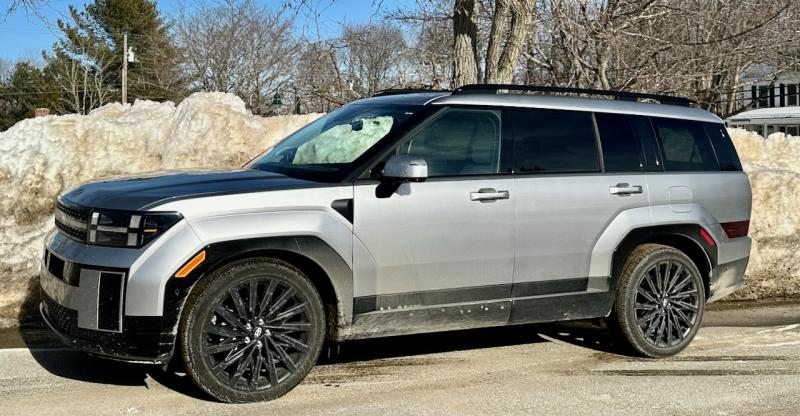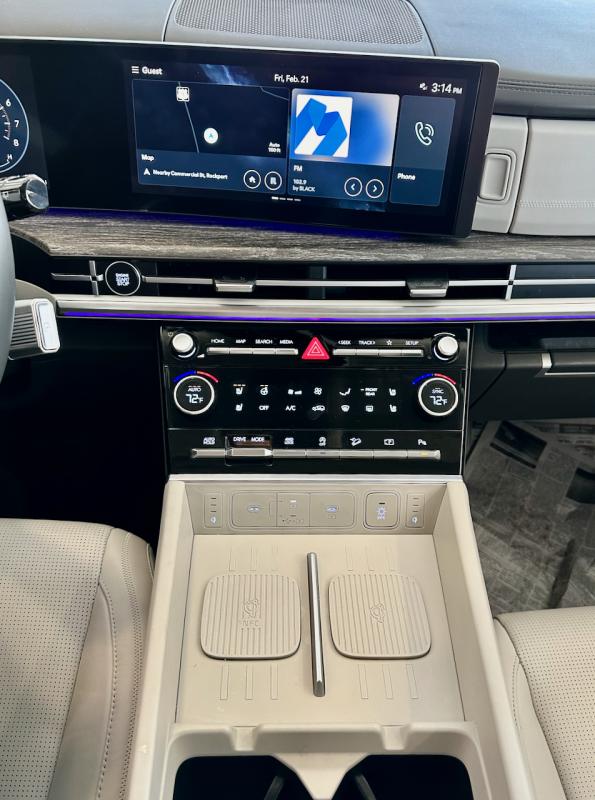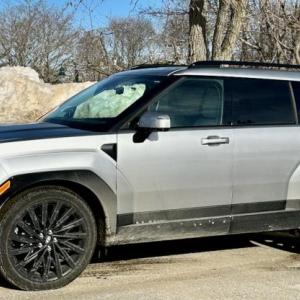Good value still: Hyundai Santa Fe Calligraphy 2.5T AWD
 The latest styling trend: Make your SUV look EV-ish while keeping it gas-powered. This is the fifth generation of Hyundai’s middle-child SUV, which helped establish the brand in the US 25 years ago. Shown here in Shimmering Silver (plus winter grime) and on 21-inch Calligraphy Exclusive wheels.
The latest styling trend: Make your SUV look EV-ish while keeping it gas-powered. This is the fifth generation of Hyundai’s middle-child SUV, which helped establish the brand in the US 25 years ago. Shown here in Shimmering Silver (plus winter grime) and on 21-inch Calligraphy Exclusive wheels.
 The re-designed-for-2024 Santa Fe’s instrument panel is curved toward the driver and incorporates the 12.3-inch-diagonal central touchscreen, which is equipped with apps galore. Note the manual controls for often-used functions, including the two-zone climate control, the available dual phone chargers and all the electrical plugs as well as two-stage steering-wheel heat and three-stage seat heat. Under this console is a capacious pass-through storage cubby.
The re-designed-for-2024 Santa Fe’s instrument panel is curved toward the driver and incorporates the 12.3-inch-diagonal central touchscreen, which is equipped with apps galore. Note the manual controls for often-used functions, including the two-zone climate control, the available dual phone chargers and all the electrical plugs as well as two-stage steering-wheel heat and three-stage seat heat. Under this console is a capacious pass-through storage cubby.
 The latest styling trend: Make your SUV look EV-ish while keeping it gas-powered. This is the fifth generation of Hyundai’s middle-child SUV, which helped establish the brand in the US 25 years ago. Shown here in Shimmering Silver (plus winter grime) and on 21-inch Calligraphy Exclusive wheels.
The latest styling trend: Make your SUV look EV-ish while keeping it gas-powered. This is the fifth generation of Hyundai’s middle-child SUV, which helped establish the brand in the US 25 years ago. Shown here in Shimmering Silver (plus winter grime) and on 21-inch Calligraphy Exclusive wheels.
 The re-designed-for-2024 Santa Fe’s instrument panel is curved toward the driver and incorporates the 12.3-inch-diagonal central touchscreen, which is equipped with apps galore. Note the manual controls for often-used functions, including the two-zone climate control, the available dual phone chargers and all the electrical plugs as well as two-stage steering-wheel heat and three-stage seat heat. Under this console is a capacious pass-through storage cubby.
The re-designed-for-2024 Santa Fe’s instrument panel is curved toward the driver and incorporates the 12.3-inch-diagonal central touchscreen, which is equipped with apps galore. Note the manual controls for often-used functions, including the two-zone climate control, the available dual phone chargers and all the electrical plugs as well as two-stage steering-wheel heat and three-stage seat heat. Under this console is a capacious pass-through storage cubby.
When the Santa Fe debuted here, for the 2000 model year, it helped propel Hyundai from a little-known Korean brand to a household word. Sales have always been strong because the Santa Fe hits an American sweet spot: a family-size, three-row SUV that’s just right—not too big and not too small. (You know, the Goldilocks thing.) Plus the Santa Fe has been available with front-wheel or all-wheel drive and has that 10-year/100,000-mile powertrain warranty, all for a notably reasonable price.
In 2025, and after a thorough refresh of the Santa Fe for MY2024, all this remains largely true, but—as for so many things post-pandemic—its sticker prices have shot upward. Yes, this is the top-of-the-tree, leather-lined Calligraphy trim package with all-wheel drive (a $1,715 add-on), but it now lists for $49,965. Yet this is only a few shekels more than the average new-car price in America today, so even a fully decked-out Santa Fe remains a relatively good value.
As a carmaker, Hyundai has matured quickly and its vehicles no longer follow trends but now set them. The Santa Fe’s fashion-forward styling continues inside, where everything is crisply squared off, appropriately high-tech and made of materials that surely weren’t supplied by the lowest bidder. Santa Fe is a ritzy ZIP Code, after all.
There’s nothing old-school about the motive power, either. This is a 2.5-litre turbocharged Four rated for 277 horsepower and 311 pound-feet of torque—one of today’s thoroughly modern, relatively small engines that performs on par with good-size Six-cylinders of yesteryear. The transmission is an automated, dual-clutch 8-speed gearbox with shift paddles.
There are the now-de rigueur multiple drive modes, too: Normal, Sport, Snow and one that can combine steering, throttle and suspension settings to the driver’s tastes. There’s even a locking center differential, which essentially converts the Santa Fe from on-demand all-wheel-drive to full-time four-wheel-drive.
Underway, everything meshes to deliver strong, if not brilliant performance and a quiet, comfortable and refined ride. The steering is light-effort but offers enough feedback to help a driver out of a dicey spot on an ice-slick road. Go ahead, ask me how I know . . . The driver also gets the full monty of active safety systems as well as a head-up display in the windshield, Apple CarPlay and Android Auto (wireless, naturally), a particularly clever multi-panel surround-view backup camera and a good deal more.
The Santa Fe is a 7-passenger vehicle with captain’s chairs in the second row, which in Calligraphy trim are heated and power-adjustable. Space is tight in the third row, so families with teenagers might consider the larger Hyundai Palisade instead of the Santa Fe (while empty-nesters might look at the two-row Tucson or Kona). The five seats in the Santa Fe’s second and third rows fold flat, leaving a yawning cavern of cargo space, accessed via a whale-sized power liftgate.
A basic Santa Fe, the SE, starts at about $35,000. Three other variants—SEL, XRT and Limited—are available before the line tops out with the Calligraphy. Hyundai now also offers a hybrid gas-electric Santa Fe that is less powerful but travels about 36 miles on a gallon of gas, almost 10 miles farther than the gas-only Santa Fe. The hybrid starts at about $38,000 and can reach $50,000.
Opinionated at any Speed will return in April, after ski season.
























